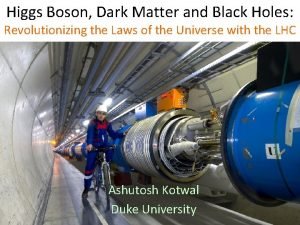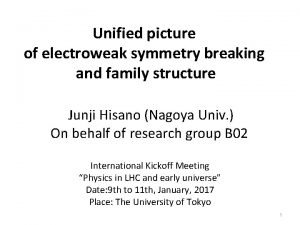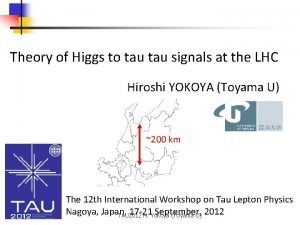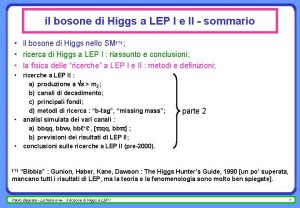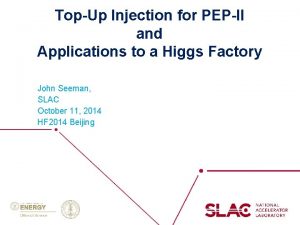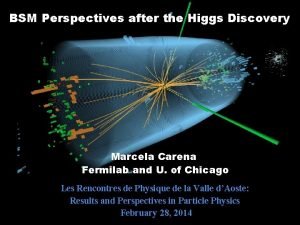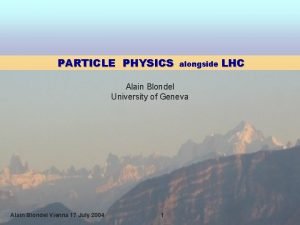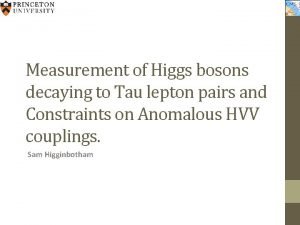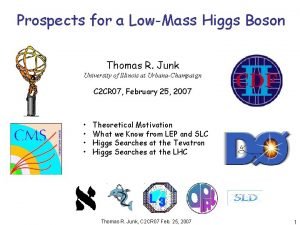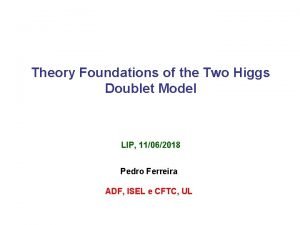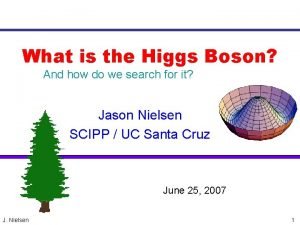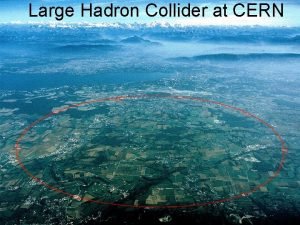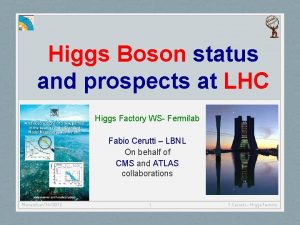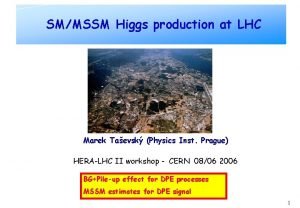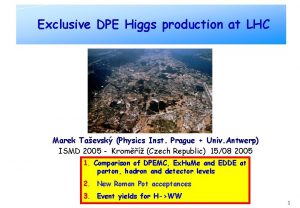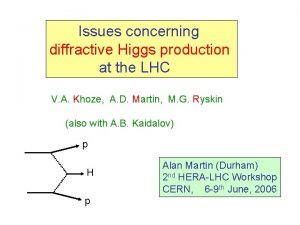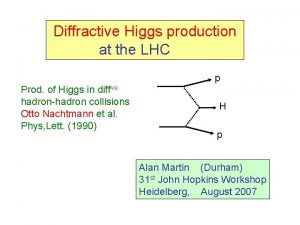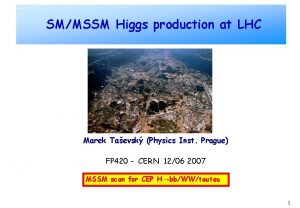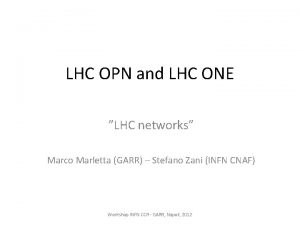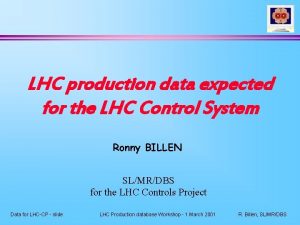Central Higgs Production at LHC from SinglePomeronExchange S

















- Slides: 17

Central Higgs Production at LHC from Single-Pomeron-Exchange S. Erhan, P. E. Schlein (UCLA) & V. T. Kim (Gatchina) hep-ph/0312342 Evidence for colorless gluon clusters (“Pomerons”) in the proton: UA 8 (CERN) observed jets in pp p. X: partonic structure H 1 (DESY) *p collisions show dominant (80 -90%) gluonic structure of these clusters. Here, we study Higgs production at LHC in pp p (HX’).


UA 8: pp (dijet X’) p at 630 Ge. V Et > 8 Ge. V A. Brandt et al. , Phys. Lett B 297 (1992) 417.

-dependence in Flux Factor The most likely Pomeron momentum fraction is near zero. The Regge-pole description of exchange process is: FP/p( , t) ≈ 1 -2 a(t) where: (t) = 1 + + ´ t At fixed-t, =1 - FP/p( ) ≈ 1/ n Experimentally, (t) is not a fixed Regge trajectory. and ´ depend on energy in pp interactions and are different in ep interaction. At t=0, n = 1. 06 - 1. 32

Empirical evidence for gluon-clusters Diffractive processes occur because of the existence of colorless gluon-dominant clusters (for example, digluons) in the partonic sea of a proton which interact with the other beam proton. There is now very solid empirical evidence for the existence of such clusters. UA 8 (CERN) observed jets in pp p. X, demonstrating the partonic structure of the clusters and their very hard internal structure (“Super-Hard”) H 1 (DESY) studied high-Q 2 p collisions and showed the dominant gluon structure of these clusters.

LHC Kinematics of pp --> p (H Y) 1 2 M H 2 = 1 2 s x H = 1 - 2 Assume 1 comes from intermediate Pomeron: 1 = x. H 2 M = - H s

UA 8: Feynman-x of dijet in Pp c. m. Pomeron is “Super-Hard”. 30% of events have x(2 -jet) larger than predicted by the hard structure function (1 -x). (b) Shows prediction when 1 gluon has entire Pomeron mom. x(2 -jet)

3 possible Pom. structure functions “Soft” Fg/P( ) = 6 (1 - )5 “Hard” Fg/P( ) = 6 (1 - )1 “Super-Hard” Fg/P( ) = = 0. 7 [6 (1 - )] + 0. 3 [19. 8 8 (1 - )0. 3] Momentum sum rule is assumed. The constituents of the Pomeron carry all its momentum

Higgs cross section in Pp collisions Ingelman and PS, Phys. Lett. 1985 where:

Higgs P(longitudinal) in Pom-prot c. m. As in UA 8 dijet analysis, the hard Pomeron causes the Higgs to emerge in the Pomeron hemisphere. Dijet analysis at LHC will quickly lead to the best knowledge of Pomeron structure and its Q 2 evolution.

Higgs P(long. ) in lab for 4 Mx values The kinematic correlation between Mx and Higgs P(longitudinal) provides an additional background suppression tool. Select Mx bin and the corresponding P(long. ) bin which selects most of Higgs signal.


pp -> p(HX) cross section vs. Mx Cross section for 120 Ge. V mass Higgs depends very weakly on in the range 0 to 0. 1 (only by a factor of two. �).

Total SPE Higgs cross section, 2 arms SPE rate 7 -9% of total What about dijets ? Etmin (dijets) = 19 nb (40 Ge. V) (dijets) = 11 nb (50 Ge. V) (dijets) = 7 nb (60 Ge. V) Integrated luminosity of 1036 will yield 11, 000 dijets with Et > 50 Ge. V. (uncertainty factor 2 -3)

All Higgs P(long. ) in lab; LHC & Te. V.

Conclusions 1. Higgs production dominantly central. PYTHIA studies are underway. TOTEM will suppress bknd. 2. Dijet studies at the young LHC will greatly contribute to better understanding the Pomeron. Longitudinal dijet momentum distributions in the Pomeron-proton cm lead to Pomeron structure. 3. Measure: = (pp->p dijet) K (Pp->p dijet) = (pp->p X) K (Pp->p X) Over all xi and t. Extract upper right and compare with prediction to determine K. UA 8 found K = 0. 5 * Donnachie-Landshoff value of 0. 78 Ge. V-2

Higgs detection & background Assertion: Although certain types of background are irreducible, for example gg bb, a general reduction of hadronic activity in the final state must improve Higgs detection and isolation capability. In a typical LHC interaction, in which a 120 Ge. V Higgs boson is produced, a gluon participating in the fusion process has only about 1% of the 7 Te. V beam energy. But, in Pomeron-exchange processes (“diffraction”), most of the excess beam energy is carried away by a single proton on one or both sides of the interaction, thereby lowering the general hadronic activity.

